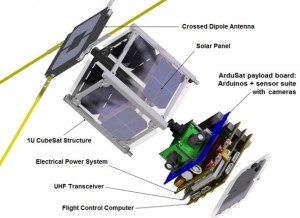Create a free profile to get unlimited access to exclusive videos, sweepstakes, and more!
Blasts of high-energy radiation from Earth win a spot on a satellite

 A few weeks ago, the small company NanoSatisfi announced a Kickstarter campaign to launch a small satellite called ArduSat into Earth orbit. This satellite would have contributions from the public both for funding and for experiments they could do on the diminutive device. Discover Magazine partnered with NanoSatisfi to run a contest where people could submit their own ideas for the satellite, and asked me to judge.
A few weeks ago, the small company NanoSatisfi announced a Kickstarter campaign to launch a small satellite called ArduSat into Earth orbit. This satellite would have contributions from the public both for funding and for experiments they could do on the diminutive device. Discover Magazine partnered with NanoSatisfi to run a contest where people could submit their own ideas for the satellite, and asked me to judge.
And judge I did, along with several other folks. And now we have a winner: Enrique Gomez, who wants to observe gamma rays emitted by lightning flashes on Earth! Through processes still not completely understood, the tremendous energy of lightning bolts, coupled with their incredibly focused magnetic fields, can generated bursts of high-energy light called gamma rays - it's like the light we see, but every photon has millions of times the energy of visible light. These Terrestrial Gamma ray Flashes (or TGFs) are difficult to detect, and not a lot is known about them. Are they sent out in all directions, like light from a light bulb, or are they beamed, like light from a light house? If they're beamed, do they go straight up, or at an angle?
Using a clever combination of instruments on the ArduSat, Gomez proposed detecting these TGFs to narrow down possible solutions to these questions. His idea was well thought-out and had solid physics backing it up, so we think it has a good chance of working on the ArduSat.
 For his part, the idea that ArduSat is open source, and that the science will be made available to everyone, appealed to Gomez:
For his part, the idea that ArduSat is open source, and that the science will be made available to everyone, appealed to Gomez:
I believe all science is a "social science" in that we advance questions about nature as a community. Space science should be no exception. When I read in KickStarter about ArduSat, I knew I had to support it because it speaks to me about this belief. ArduSat is a prime example of two ideas that are worth sharing widely. The first is community supported science. People care about scientific and technological problems and thus they can gather their resources to answer them. The second is citizen science. People can not only ask scientific questions but can also work together as a community to answer them irrespective of their scientific or technical background. This is also where the open source spirit of Arduino technology comes into play by making even the technical dimension of a scientific project as accessible as possible. The project that I proposed came from my fascination with sky phenomena. There are so many mysteries in the Earthâs atmosphere between the troposphere and the ionosphere, which beg for inquisitive minds.
For his experiment, Gomez will receive a $1500 Development Kit for hardware and a week of uptime on the ArduSat to perform his tasks.
But he's not the only one with time on the satellite: well over 100 people backed the KickStarter at a level that will give them access to the satellite in one way or another, from aiming it to take pictures up to getting a week of time on the bird.
I have to say, this is amazing to me. We live in an era where someone can take the kind of money they would spend on a decent set of clothes or a bicycle, and use it to help build and command a satellite! Between things like this, and launch costs about to drop due to private companies getting into the launch biz, I wonder what we'll be seeing just a few years down the line?
My thanks to the folks at NanoSatisfi and Discover (and you too, Darlene!) for asking me to be a part of this.
Image credits: NanoSatisfi; NASA


























